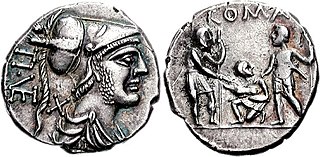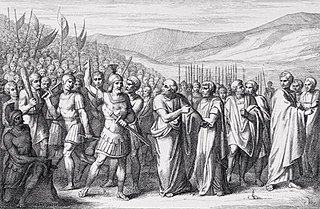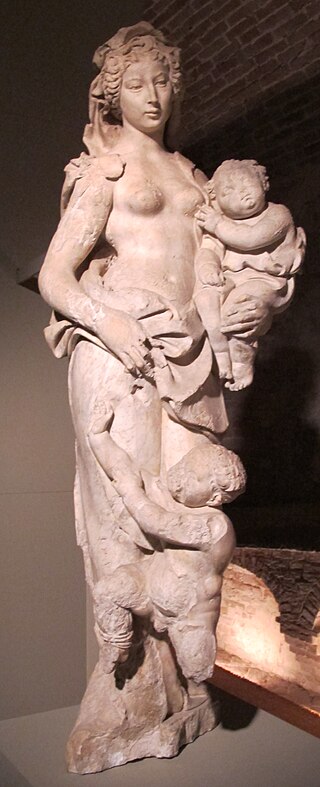
The Mons Sacer, Sacer Mons, or Sacred Mount is a hill in Rome, famed as the location of the first secession of the plebs, in 494 BC. [1]

The Mons Sacer, Sacer Mons, or Sacred Mount is a hill in Rome, famed as the location of the first secession of the plebs, in 494 BC. [1]
The Mons Sacer is a hill northeast of the Anio, the modern Aniene, a little above the confluence of the Anio with the Tiber. It was about three miles northeast of the ancient city, north of the Via Ficulensis, [2] [3] but now lies within the boundaries of modern Rome, where it gives its name to the Monte Sacro quarter. To the east and southwest, the hill descends steeply to the valley of the Anio, while to the north the hill is connected with a plateau extending away from the city. A small stream, the Rivus Ulmanus, or stream of elms, descends from the steep eastern slope. [4] [1]
The name of the Sacred Mount might be derived from its use as the site of rituals by augurs or haruspices, but according to the historians, it took its name from the lex Sacrata (Sacred Law) that ended the first secession, which was passed and commemorated by an altar on the hill. [5] [6] The occasion for this law was strife between the patricians, the hereditary aristocracy of ancient Rome, who held nearly all of the city's political and economic power, and the plebeians, the common folk, who formed the majority of the city's population. This conflict of the orders reached its head in 494 BC, when faced with crushing debt, the plebeians appealed to the Roman Senate for relief, and were rebuffed. They then seceded en masse to the Sacred Mount, where they elected their own leaders, and refused all entreaties by the patricians to return. [2] [7]

This standoff was resolved when the Senate, fearful of war with the Sabines, and faced with the lack of an army to fight on the city's behalf, sent envoys known to be favourably disposed to the plebs, led by Agrippa Menenius Lanatus. Menenius and his colleagues argued that neither the patricians nor the plebeians could survive without the other, and agreed to a series of concessions to induce the people to return to the city. The most important of these established two annual offices to be elected by the plebeian assembly alone: the aediles, who took charge of the city's temples, public buildings, and religious festivals, and the tribunes of the plebs, who could advocate and propose legislation on behalf of the plebeians, and veto the actions of the magistrates or other officials. [8] [9] [6]
In 449 BC, the plebeians seceded from the city for a second time, in protest of the tyranny of the second decemvirate. According to Livy, they first withdrew to the Aventine Hill, in the southern end of Rome, but finding the decemvirs unmoved, they resolved to desert the city for the Sacred Mount, hoping that the symbolism of that hill and its role in the first secession would stir the decemvirs to action. They marched out of the city along the Via Ficulensis, and once again stationed themselves on the Mons Sacer, where they remained until the senate's envoys were able to negotiate their return. [10] Cicero reports these events in reverse, stating that the plebeians first seceded to the Sacred Mount, then returned to the city and occupied the Aventine Hill. [11]
The Sacred Mount plays no significant role in Roman history after these secessions. In the mid-nineteenth century the hill was uninhabited. [1] Today it forms part of Municipio III, within the city of Rome.
Tribune of the plebs, tribune of the people or plebeian tribune was the first office of the Roman state that was open to the plebeians, and was, throughout the history of the Republic, the most important check on the power of the Roman Senate and magistrates. These tribunes had the power to convene and preside over the Concilium Plebis ; to summon the senate; to propose legislation; and to intervene on behalf of plebeians in legal matters; but the most significant power was to veto the actions of the consuls and other magistrates, thus protecting the interests of the plebeians as a class. The tribunes of the plebs were typically found seated on special benches set up for them in the Roman Forum. The tribunes were sacrosanct, meaning that any assault on their person was punishable by death. In imperial times, the powers of the tribunate were granted to the emperor as a matter of course, and the office itself lost its independence and most of its functions.

Agrippa Menenius Lanatus was a consul of the Roman Republic in 503 BC, with Publius Postumius Tubertus. He was victorious over the Sabines and was awarded a triumph which he celebrated on 4 April 503 BC. According to Livy, he also led Roman troops against the Latin town of Pometia. In some traditions he and his colleague also completed a census during their consulship.

Lucius Minucius Esquilinus Augurinus was a Roman politician in the 5th century BC, consul in 458 BC, and decemvir in 450 BC.
Secessio plebis was an informal exercise of power by Rome's plebeian citizens between the 5th century BC and 3rd century BC., similar in concept to the general strike. During the secessio plebis, the plebs would abandon the city en masse in a protest emigration and leave the patrician order to themselves. Therefore, a secessio meant that all shops and workshops would shut down and commercial transactions would largely cease. This was an effective strategy in the Conflict of the Orders due to strength in numbers; plebeian citizens made up the vast majority of Rome's populace and produced most of its food and resources, while a patrician citizen was a member of the minority upper class, the equivalent of the landed gentry of later times. Authors report different numbers for how many secessions there were. M. Cary and H. H. Scullard state there were five between 494 BC and 287 BC.
Appius Claudius Sabinus Regillensis or Inregillensis was the legendary founder of the Roman gens Claudia, and consul in 495 BC. He was the leading figure of the aristocratic party in the early Roman Republic.
Appius Claudius Crassus InregillensisSabinus was a Roman senator during the early Republic, most notable as the leading member of the ten-man board which drew up the Twelve Tables of Roman law around 451 BC. He is also probably identical with the Appius Claudius who was consul in 471 BC.
Publius Postumius Tubertus, the son of Quintus, was the first of the patrician gens Postumia to obtain the consulship, which he held in 505 BC, and again in 503. Ten years later, he was one of the envoys sent by the Roman Senate to negotiate with the plebeians during the first secessio plebis. The outcome of those negotiations reunited the Roman people, and established the tribunes of the plebs, one of the most important institutions of the Roman Republic.

The gens Veturia, originally Vetusia, was an ancient patrician family of the Roman Republic. According to tradition, the armourer Mamurius Veturius lived in the time of Numa Pompilius, and made the sacred ancilia. The Veturii occur regularly in the Fasti Consulares of the early Republic, with Gaius Veturius Geminus Cicurinus holding the consulship in 499 BC. Like other old patrician gentes, the Veturii also developed plebeian branches. The family declined in the later Republic, with the last consular Veturius holding office in 206 BC, during the Second Punic War.
The Aventine Triad is a modern term for the joint cult of the Roman deities Ceres, Liber and Libera. The cult was established c. 493 BC within a sacred district (templum) on or near the Aventine Hill, traditionally associated with the Roman plebs. Later accounts describe the temple building and rites as "Greek" in style. Some modern historians describe the Aventine Triad as a plebeian parallel and self-conscious antithesis to the Archaic Triad of Jupiter, Mars and Quirinus and the later Capitoline Triad of Jupiter, Minerva and Juno. The Aventine Triad, temple and associated ludi served as a focus of plebeian identity, sometimes in opposition to Rome's original ruling elite, the patricians.

The gens Sicinia was a plebeian family at ancient Rome. Members of this gens occur throughout the history of the Republic, but only one of them obtained the consulship, Titus Sicinius Sabinus in 487 BC. Throughout the long Conflict of the Orders, the Sicinii were celebrated for their efforts on behalf of the plebeians.

The first secessio plebis was a significant event in ancient Roman political and social history that occurred between 495 and 493 BC. It involved a dispute between the patrician ruling class and the plebeian underclass, and was one of a number of secessions by the plebs and part of a broader political conflict known as the conflict of the orders.
Gaius Julius Iullus was a Roman statesman, who held the consulship in 482 BC. After a contentious election, he was chosen to represent the more moderate faction in Roman politics, while his colleague, Quintus Fabius Vibulanus, was elected by the aristocratic party. Both consuls led a Roman army against Veii, but withdrew when the Veientes refused to confront them. Thirty years later, in 451, Julius was chosen a member of the first decemvirate, alongside several other ex-consuls and other respected statesmen. Julius proved himself a man of good judgment and integrity, and helped to draw up the first ten tables of Roman law.
The gens Icilia was a plebeian family at ancient Rome. During the early Republic, the Icilii were distinguished by their unwavering support for the rights of the plebeians against the patrician aristocracy.
The gens Manilia was a plebeian family at ancient Rome. Members of this gens are frequently confused with the Manlii, Mallii, and Mamilii. Several of the Manilii were distinguished in the service of the Republic, with Manius Manilius obtaining the consulship in 149 BC; but the family itself remained small and relatively unimportant.
Titus Antonius Merenda was a Roman politician, and decemvir from 450 to 449 BC.
Spurius Oppius Cornicen was a Roman politician and member of the Second Decemvirate in 450 and 449 BC.
Quintus Poetelius Libo Visolus was a Roman politician, and member of the Second Decemvirate in 450 and 449 BC.
Caeso Duillius Longus was a Roman politician, a member of the Second Decemvirate in 450 and 449 BC.
The gens Oppia was an ancient Roman family, known from the first century of the Republic down to imperial times. The gens may originally have been patrician, as they supplied priestesses to the College of Vestals at a very early date, but all of the Oppii known to history were plebeians. None of them obtained the consulship until imperial times.

Remoria is a place associated with the legendary founding of Rome by Romulus and Remus where, according to Roman tradition, Remus saw six birds land and which he chose as an auspicious location for the future city. Some variants of the legend say that Remoria was also the place where Remus was buried after he was killed by Romulus.